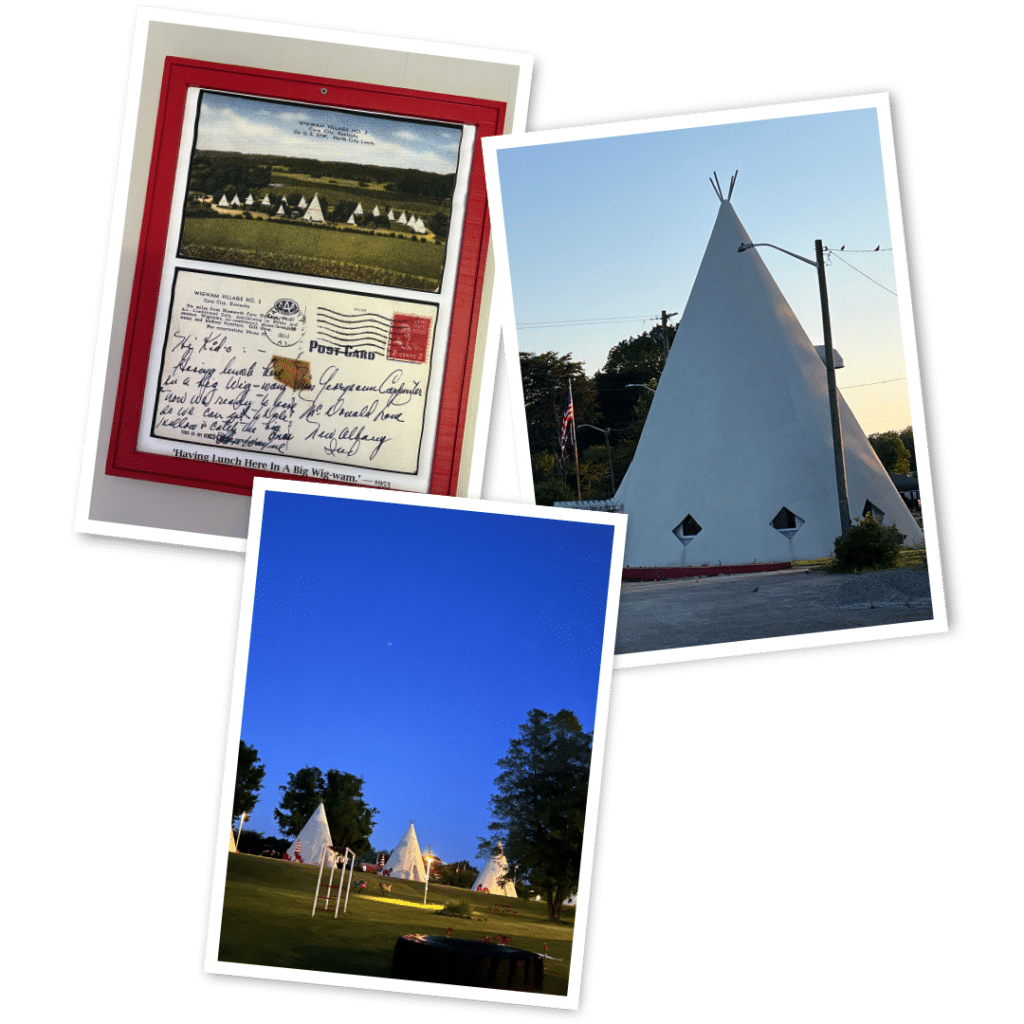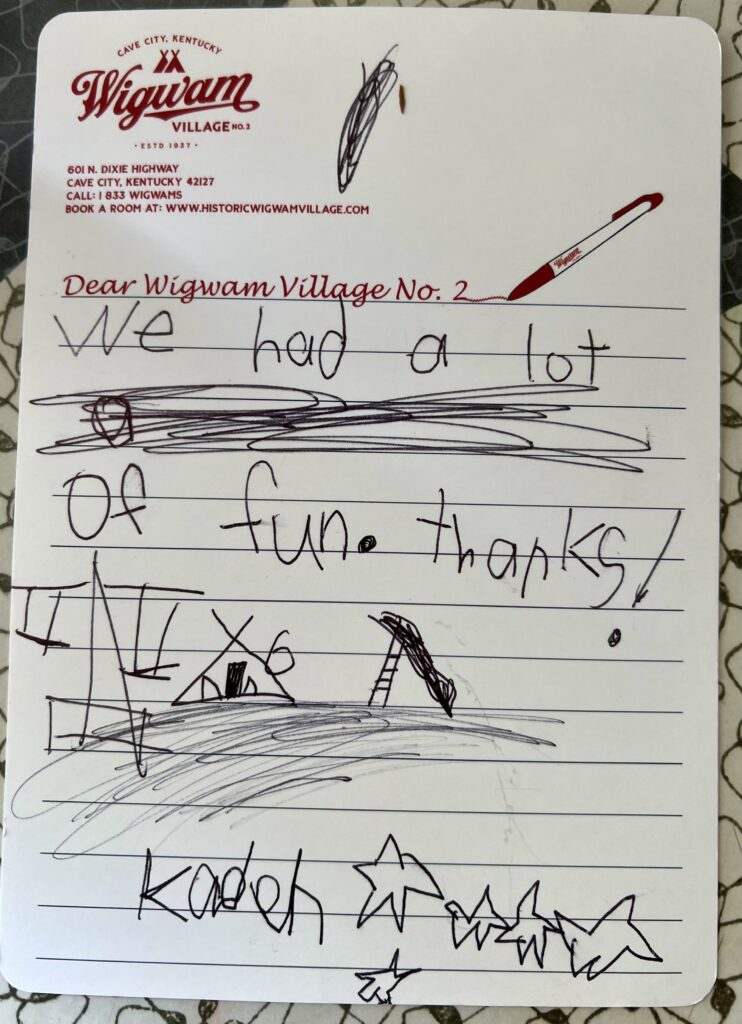“I’m either never telling anyone about this, or I’m telling everyone about this. I’m just not sure which one yet.”
Those were my exact words when my husband, Jeff, and I were planning a trip to Cave City, Kentucky, and he said, “We can stay at a typical chain hotel, or we can stay at a place called Wigwam Village #2, in a concrete teepee, on a big open property with lots of other teepees.
He knew before asking that I would vote teepee (obviously!). But I had so many questions. Why “Wigwam” if they are teepees? What’s the “#2” all about? Why the communal vibe? And (awkward), isn’t this somewhere between “probably” and “definitely” cultural appropriation? Should we even be doing this?
I’ll get into all of that, plus some fun Americana history and — most importantly! — what this has to do with you and how you can create more superfans in your business. There are tons of lessons here.
Let’s travel back in time…
How would you market your business differently if there were no internet, cellphones, or home televisions?
It’s hard for many of us to imagine that world, but less than a century ago, those were the realities for every business. Sure, you might be able to afford some newspaper ads or radio commercials (read live on air!) or direct-mail postcards to promote your business — you might even luck into some free publicity from a local reporter! — but a lot of your strategy looked like this:
#1 – Be interesting enough for someone to stop when they walk or drive by your business.
#2 – Be remarkable enough once they’re there that customers make it a point to come back and tell other people to visit, too.
That’s still a solid one-two punch if you can pull it off. Some (including some named Brittany) might argue it’s the best strategy. But that first half, being interesting enough to get someone’s attention, led to some pretty novel ideas from business leaders in the pre-Internet days, especially as more Americans started buying automobiles and exploring further away from home.
The Roaring ‘20s in America saw the birth of an outlandish new style of architecture, now known as mimetic architecture, where whimsical or over-the-top structures were created to mimic other items, often synonymous with whatever business was happening inside.
One of the first big examples was the Brown Derby Restaurant, which opened in L.A. in 1926.

Photo by Chalmers Butterfield CC BY 2.5
Five years later, a 20-foot-tall aptly-named “Big Duck” was constructed on Long Island to sell ducks and duck eggs to passersby.

Photograph by Mike Peel (CC-BY-SA-4.0.
Other fun examples may come to your mind. There’s the iconic Randy’s Donuts in Inglewood, several ice cream chains selling tasty treats from soft-serve-inspired buildings, and cafes shaped like coffee cups and tea kettles.
The purpose with this type of architecture, of course, is to get people’s attention. To overpower their apathy and get them to stop… and spend. Once upon a time, before Instagram feeds, the only chance you had to capture someone’s attention might be as they were driving by your little stretch of land.
Betcha I Can Make You Look
In the 1930s, a man from Horse Cave, Kentucky, named Frank Redford, was on a vacation in Long Beach, California. He happened across a roadside restaurant called Tee Pee Barbeque selling (wait for it…) barbeque food… from a concrete teepee. Two smaller teepees on either side of the restaurant served as restrooms.
Frank, who had been interested in Native American culture since childhood, thought it was brilliant. He returned to Kentucky and, essentially, ripped off the idea. In 1933, he built a near-identical concrete teepee restaurant, selling ice cream, flanked by two smaller teepee restrooms.
By 1935, despite the Great Depression, Frank’s restaurant was thriving. Horse Cave, KY, was a tourist town, and car culture was thriving. People began asking Frank, “If you were going to build teepees, why didn’t you make them motel rooms for people to sleep in?” He replied like many entrepreneurs would: “I can do that!” He eventually added six concrete teepee hotel rooms to the property.
Frank named his motel “Wigwam Village” because he thought it sounded better than “Teepee Village.” With his first property thriving, he opened Wigwam Village No. 2 a few miles away in the tourist hot spot of Cave City in 1937. Armed with a design patent for the concept and concrete structure, he began franchising his idea and, soon there were seven Wigwam Villages across America, decorating Route 66 and other tourist roadways from coast to coast. Two others still exist, in San Bernardino, California, and Holbrook, Arizona.
The history of the franchise is fascinating and, honestly, I could write a lot more about it. But I promised you some customer experience takeaways, so I’m going to move on. If you want to learn more about Wigwam Village No. 2, its current owners (more on them soon) put together this wonderful book.

Cool History Lesson, But Get To The Experience
I’ll admit, I did almost no Googling before arriving onsite. All I knew was that there were two more surviving Wigwam properties and Oprah stayed at one of them on a TV show, so I figured it was okay.
When my husband and I arrived with our boys, one of the owners, Keith, met us outside. He invited us to join him on a porch for what he described as “about a 12-minute welcome orientation.”
I immediately had a flashback to a timeshare presentation I’d once been duped into attending in Vegas and feared the worst. But to my surprise, our 12 minutes with Keith were a blast! In that time, he gave us a brief history of the Wigwam Village, told us why he and his business partner, Megan, decided to buy the motel as a post-Covid project (“Why not?,” essentially), and made a passionate plug for what he considers to be the most special part of the Wigwam Village experience: the communal aspect.
The 15 teepees at the motel are arranged in a semi-circle on a four-acre lot, surrounding a vintage playground and fire pit. Every night around dusk, there’s a campfire. Guests are encouraged to get to know each other and trade stories under the moonlight.
“It was something of a social experiment 85 years ago,” Keith explained. “You had the privacy of your own room, but the fun of visiting with other travelers.”
The new owners of Wigwam Village No. 2 (presumably) don’t read this email, but they nailed every pillar of the SUPER Model.
S: Start With Your Story
Keith literally started off our visit by telling us his story. He didn’t even gloss over the parts my six-year-old would call “sus”; in fact, he addressed the appropriation thing head on, before we asked the question. He encouraged us to check out the book in our teepee for a complete history of the motel and information about the history of Native Americans in Kentucky.
Your Takeaway:
How can you invite your customers into your story right off the bat? How can you give them the opportunity to opt-in on a deeper level, like the owners did with the in-room book?
U: Understand Your Customers’ Story
Keith proactively gave us the rundown on things like his favorite local places to eat (their giant teepee-shaped restaurant, called the “BigWam,” hasn’t re-opened yet!), how to connect to the wifi, and where to find things like an ice machine or a microwave. He also asked about the adventures we’d had so far (“Please tell me you’ve been to a cave?”) and how much time we had to explore the next day so he could recommend his favorite attractions.
Your Takeaway:
It’s always great when you can answer your customers’ questions before they ask. And, when you bring curiosity to your conversations to get to know them, you earn their trust. That gives much more credibility to your suggestions.
P: Personalize
Keith’s welcome orientation ends by letting us know that we’re part of the Wigwam Village family. He encourages us to connect with them on socials. When we did, we found that they share TONS of pictures and stories… which makes it fun! You start thinking, “I’m looking forward to coming back” even before you leave.
Your Takeaway:
Don’t let the story end once your customer’s first transaction ends. Keep it going! Invite them into something that keeps going.
E: Exceed Expectations
Many aspects of the experience exceeded our expectations, including the attention to detail in the rooms. Vintage furnishings (many of them original to the rooms, but refinished) and framed retro decor (including replicas of ads, postcards, and even design patent applications for the motel) were the perfect touch. The campfire was a blast, too!
Your Takeaway:
There’s no such thing as a small detail. Showing that you care about the little things shows that you care about the big picture.
R: Repeat
There are 15 teepees at the motel, which means the owners have to give the “welcome” spiel up to 15 times a day. Yes, that’s a lot. Up to 3 hours, in fact. Yes, it could probably be shorter. But when you’ve got the time to spend talking to your customers, do it. The ROI is likely spectacular. Are customers more likely to come back, tell their friends, or write absurdly long emails when you invest that much time? Yep. 🙂
Your Takeaway:
Treat every customer like an influencer, because in many ways, they are! Create systems to make doing the SUPER thing as automatic as doing the easy thing.
Speaking of “Repeat,” Is Memetic Architecture Still A Thing?
Thankfully, yes! And not just the pop-up kind you hear about around movies (like Airbnb’s Barbie DreamHouse or Up House) or hotels on the Vegas Strip. One of my favorite recent examples of mimic architecture is the parking garage at the Kansas City Central Library. It showcases 22 book titles — chosen by Kansas City residents and library trustees — that are 25 feet tall and span nearly 200 feet. For more fun examples (including the world’s largest dinosaur!), see here.
The Final Verdict
I hope you’ve enjoyed this newsletter, and I hope you’ve learned at least a few fun things you didn’t know before. If you’ve ever been to a Wigwam Village — or if this newsletter has encouraged you to go — please hit “reply” and share your story with me!
I can’t think of any better way to end this very long review than with a very short one: the first one my six-year-old has ever written, in fact! When he noticed the notecard sitting on the table in our room, he asked if he could leave “the note.” Here’s his first-ever review… and a five-star one at that! Which you probably won’t be surprised to learn that Wigwam Village No. 2 shared. 😀

